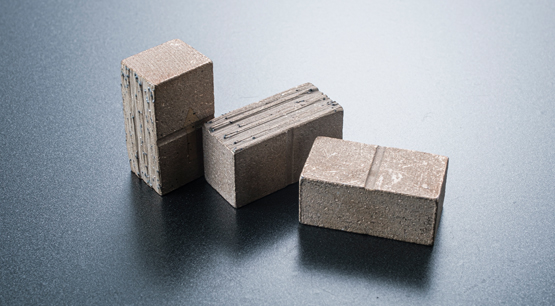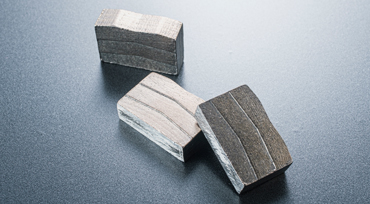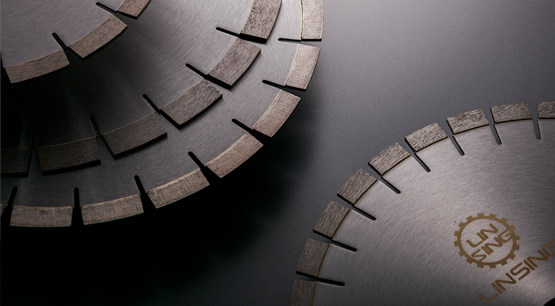Diamond segments are the critical components of diamond saw blades, directly impacting cutting performance. The production of diamond segments involves multiple steps, each requiring precise operations and stringent control. The following is a detailed explanation of the production process of diamond segments:
I. Raw Material Preparation
1. Diamond Particles
- Selection: Choose appropriate diamond particles based on the hardness of the material to be cut and the required cutting efficiency. Both natural and synthetic diamonds are commonly used.
- Screening: Classify diamond particles through a sieving process to ensure uniform particle size, which guarantees consistent cutting performance.
2. Bonding Materials
- Metal Powders: Commonly used metal powders include iron, copper, cobalt, and nickel. The right combination of metals is selected based on different application needs.
- Additives: Add carbides, oxides, and other reinforcing materials to enhance the bond's strength and wear resistance.
II. Mixing and Granulating
1. Mixing
- Equipment: Use a ball mill or mixer to blend diamond particles and metal powders in specific proportions.
- Uniformity: Ensure the mixture is uniform so that each diamond particle is adequately surrounded by the metal powder.
2. Granulating
- Purpose: Granulating the mixed powders helps form granules, which facilitate subsequent pressing.
- Methods: Employ methods such as spray granulation or mechanical granulation to produce powder granules with good flowability and pressing characteristics.
III. Pressing and Forming
1. Mold Preparation
- Design: Design molds according to the shape and size requirements of the segments, usually made of high-strength steel.
- Cleaning: Ensure the mold surfaces are clean to prevent impurities from affecting segment quality.
2. Powder Pressing
- Cold Pressing: Place the granulated powder into the mold and use a cold press to form the powder under pressure.
- Hot Pressing: Some segments use hot pressing, where the powder is pressed at high temperatures to increase density and strength.
IV. Sintering Process
1. Sintering Temperature Control
- Equipment: Use a vacuum sintering furnace or hydrogen protection sintering furnace.
- Temperature Curve: Develop a temperature curve based on material properties, gradually heating to the set temperature to ensure complete sintering of diamonds and the bond.
2. Sintering Procedure
- Degassing: Remove gases during sintering to prevent porosity formation.
- Soaking: Maintain the set temperature for a specified duration to ensure thorough bonding of diamonds and the bond, creating a dense segment structure.
V. Post-Processing
1. Cutting and Trimming
- Cutting: Cut the sintered segments to the required size and shape.
- Trimming: Grind and polish the segments to achieve smooth surfaces and precise dimensions.
2. Inspection and Sorting
- Visual Inspection: Check for defects such as cracks and pores.
- Dimensional Inspection: Use measurement tools to ensure segments meet size specifications.
- Hardness Testing: Test the hardness to ensure it meets required standards.
VI. Assembly and Packaging
1. Assembly
- Welding: Weld diamond segments onto the saw blade core using methods like laser welding or high-frequency welding.
- Testing: Inspect the assembled blade to ensure segments are firmly attached with no looseness.
2. Packaging
- Protective Packaging: Pack the segments to prevent damage during transportation.
- Labeling: Mark packages with product model, specifications, and production date for easy identification and use by customers.
VII. Quality Control and Certification
1. Quality Control
- Process Control: Maintain strict quality control at each production stage to ensure batch consistency and stability.
- Final Inspection: Conduct comprehensive inspections before products leave the factory, including appearance, dimensions, hardness, and welding firmness.
2. Certification
- ISO Certification: Obtain ISO quality management system certification to ensure the production process meets international standards.
- Industry Certification: Achieve relevant industry certifications as per requirements, such as CE certification for the construction industry.
Conclusion
The production of diamond segments involves multiple stages, from raw material selection, mixing and granulating, pressing and forming, sintering, post-processing, to assembly and packaging. Each stage requires precise control to ensure the quality and performance of the segments. Through scientific processes and rigorous quality control, the produced diamond segments exhibit excellent cutting performance and durability, meeting various cutting needs.











